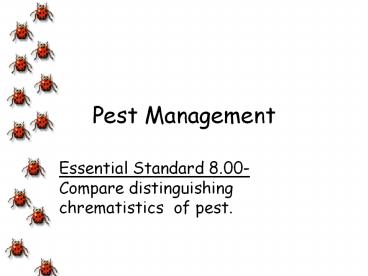Pest Management - PowerPoint PPT Presentation
1 / 30
Title:
Pest Management
Description:
Title: Pests and Diseases Author: Crest High School Last modified by: Brandon Smith Created Date: 8/4/2003 6:35:12 PM Document presentation format – PowerPoint PPT presentation
Number of Views:172
Avg rating:3.0/5.0
Title: Pest Management
1
Pest Management
- Essential Standard 8.00- Compare distinguishing
chrematistics of pest.
2
Objective 8.01
- Discuss the anatomy and life cycle of pest.
3
What is an insect?
- Small animals that have three body regions and
three pairs of legs equaling six legs - Body regions
- head
- thorax
- abdomen
4
Types of Insects
- The five types of mouthparts are important in
identifying and controlling insects. - Chewing
- Piercing-sucking
- Rasping-sucking
- Siphoning
- Sponging
5
Chewing Insects
- Insects tear, chew or grind food
- Examples
- grasshopper
- Beetle
- Cutworms
- Caterpillars
- Damage by chewing insects includes tearing,
chewing, or grinding all parts of the plant
6
Piercing-Sucking Insects
- Punctures plant and sucks the sap usually from
underside of the leaves or the stem - Examples
- Aphids
- Mealy bugs
- Mites
- Scale
- whiteflies
- Damage causes yellow spotted leaves which result
in stunted growth
7
Rasping-Sucking insects
- Rasps or breaks surface and sucks sap
- Example
- thrips
- Damaged plant tissue becomes speckled and white
8
Siphoning insects
- Have a coiled tube they dip into liquid food such
as nectar and draw it in - Example
- butterflies
- Siphoning insects do little to no damage to the
plant
9
Sponging Insects
- Have two sponge-like structures that collect
liquid food and move it into the food canal - Example
- houseflies
- Sponging insects can carry germs or diseases that
can damage plants
10
Life Cycles
- Complete metamorphosis has four stages
- egg
- larva-worms or caterpillars
- Pupa- resting stage
- adult-flies, beetles, etc.
11
Life Cycles
- Incomplete metamorphosis has three stages
- egg
- Nymph- baby insect
- Adult
- Insects must be killed when they are feeding or
actively moving on the plant
12
Life Cycles
13
Chewing Insects
- Parts of leaves are eaten away
- beetles
- cutworms
- caterpillars
- grasshoppers
14
Chewing Insects
- Beetles
- eat leaves, stems, flowers, fruit and nuts
- Cutworms
- usually attack stems, but may eat other plant
parts
15
Chewing Insects
- Caterpillars
- larva of moths and butterflies
- fuzzy or hairy
- eat young leaves and stems
- roll up in leaves making leaves curl
- Grasshoppers
- eat all parts of plants
16
Sucking Insects
- Aphids
- Leaf bugs
- Mealy bugs
- Scale
- Thrips
- Whiteflies
17
Aphids
- Pierce and suck juices
- known as plant lice
- cause stunted growth and yellow spotted leaves
- causes sticky substances and black mold
- will attract ants
18
Aphids
19
Leaf Bugs
- Cause plants to look unhealthy
- plants will lose their normal color and wilt
20
Leaf Bugs
21
Mealy Bugs
- Pierce and suck from underside of leaves and in
leaf axils causing yellow appearance and sticky
secretions
22
Mealy bugs
23
Scale
- Appear as black or brown raised lumps attached to
stems and underside of leaves causing yellow
leaves and stunted growth
24
Scale
25
Thrips
- Chew and then suck causing plant tissue to become
speckled or whitened, leaf tip to wither, curl
up, or die
26
Thrips
27
Whiteflies
- Feed on underside of young leaves causing
yellowing - will look like flying little white specks when
plants are shaken
28
Whiteflies
29
Mites
- Attack underside of leaves causing gray to
grayish-green spots - severe infestations cause webbing
30
Mites































